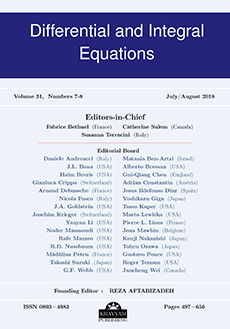Abstract
We consider the operator $ H=\varepsilon h+\cos(\alpha\cdot j+\vartheta) $ for $j\in\mathbb{Z}^\nu, $ where $h$ is self-adjoint, translation invariant and finite range. The vector $\alpha=(\alpha_1,\alpha_2,\dots,\alpha_\nu)$ is assumed to have the diophantine property $ |j\cdot\alpha\,\text{mod}\,2\pi|\ge C/|j|^2, $ where $j\ne0$ and $C$ is some constant. For $\varepsilon$ sufficiently small we prove that $H$ has pure point spectrum for almost every $\vartheta$. Moreover, every polynomially bounded eigenfunction of $H$ decays exponentially fast. Finally, we will show how this operator comes up in the study of electrons in a transverse magnetic field subject to a two dimensional periodic potential.
Citation
Steve Surace. "A finite range operator with a quasi-periodic potential." Differential Integral Equations 9 (1) 213 - 237, 1996. https://doi.org/10.57262/die/1367969998
Information





